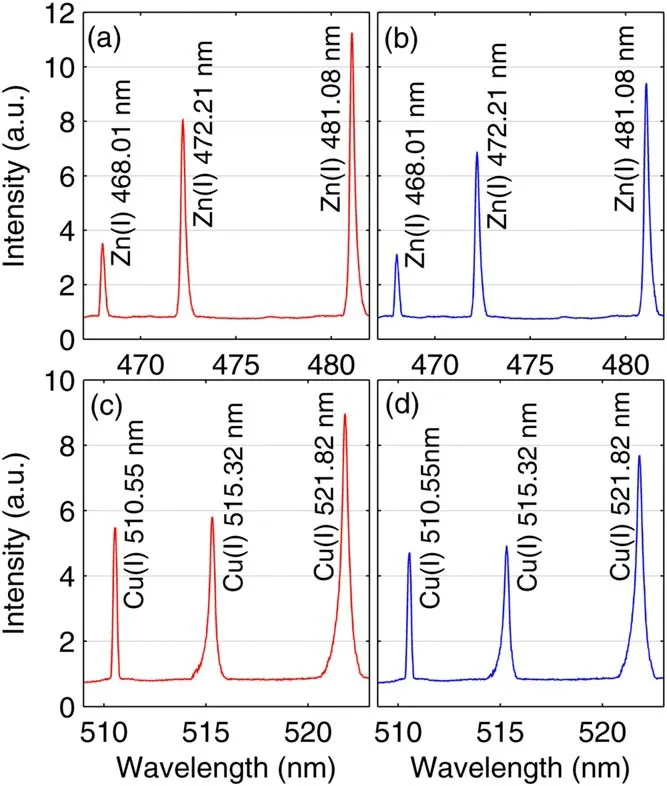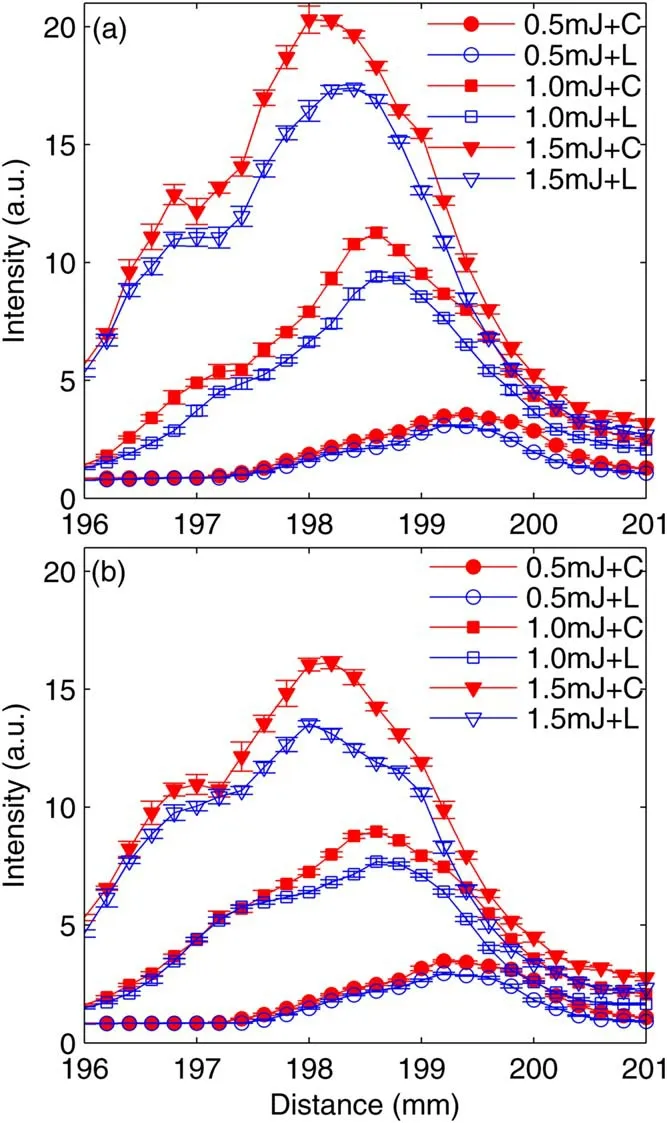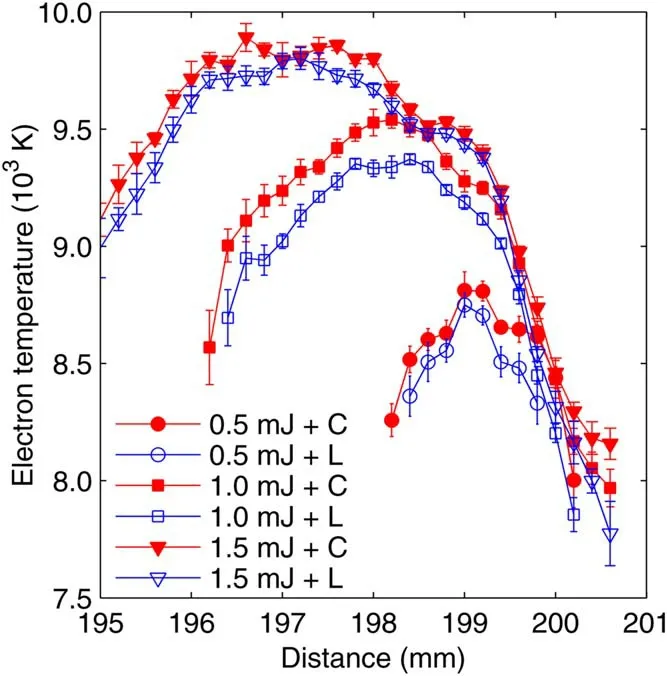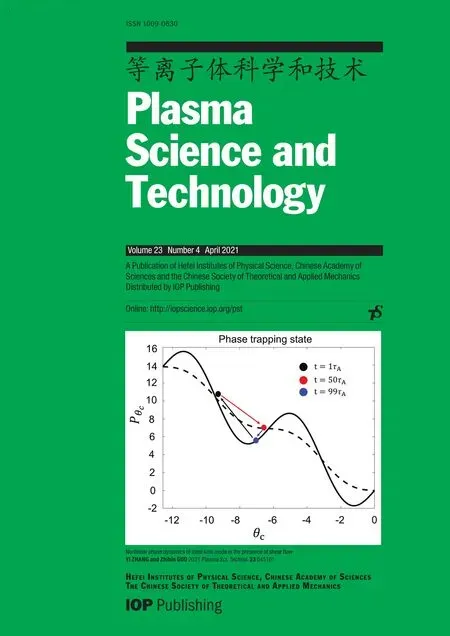Comparison of emission signals for different polarizations in femtosecond laser-induced breakdown spectroscopy
2021-04-22QiuyunWANG王秋云AnminCHEN陈安民MiaoLIU刘淼YitongLIU刘奕彤QingxueLI李庆雪SuyuLI李苏宇YuanfeiJIANG姜远飞XunGAO高勋andMingxingJIN金明星
Qiuyun WANG(王秋云),Anmin CHEN(陈安民),∗,Miao LIU(刘淼),Yitong LIU(刘奕彤),Qingxue LI(李庆雪),Suyu LI(李苏宇),Yuanfei JIANG(姜远飞),Xun GAO(高勋)and Mingxing JIN(金明星),∗
1 Institute of Atomic and Molecular Physics,Jilin University,Changchun 130012,People’s Republic of China
2 School of Science,Changchun University of Science and Technology,Changchun 130022,People’s Republic of China
Abstract In this study,a femtosecond laser was focused to ablate brass target and generate plasma emission in air.The influence of lens to sample distance(LTSD)on spectral emission of brass plasma under linearly and circularly polarized pulses with different pulse energies was investigated.The results indicated that the position with the strongest spectral emission moved toward focusing lens with increasing the energy.At the same laser energy,the line emission under circularly polarized pulse was stronger compared with linearly polarized pulse for different LTSDs.Next,electron temperature and density of the plasma were obtained with Cu(I)lines,indicating that the electron temperature and density under circularly polarized pulse were higher compared to that under linearly polarized pulse.Therefore,changing the laser polarization is a simple and effective way to improve the spectral emission intensity of femtosecond laserinduced plasma.
Keywords:laser-induced breakdown spectroscopy,femtosecond pulse,polarization,lens to sample distance,emission enhancement
1.Introduction
Laser-induced breakdown spectroscopy(LIBS),based on atomic emission spectroscopy,is a technique for material component analysis.Its basic principle is to focus a beam of laser on the material surface,the material vaporizes instantly,forming a high-temperature and high-density plasma.The plasma can emit photons with some specific wavelengths[1-7],and some useful information can be obtained by collecting and analyzing the plasma emission signal.Because the wavelength of a spectrum corresponds to specific elements one by one,the composition and content of the elements in the target can be determined according to the emission wavelength and intensity.The LIBS technique can be used for all substances,and perform multi-element simultaneous analysis,no sample collection and pretreatment,fast,in situ,and online detection compared to some other spectral methods,such as atomic absorption spectroscopy,plasma mass spectroscopy,and atomic fluorescence spectroscopy[8-10].So it can be used in industry,agriculture,environmental detection,isotopic detection,biomedicine,and many other fields[11-15].
In the past 50 years,LIBS has developed from long pulse nanosecond LIBS(ns-LIBS)to ultrafast pulse femtosecond LIBS(fs-LIBS)with the development of laser technology and spectral analysis instrument.The disadvantage of ns-LIBS is that the laser irradiates the target for a long time,and the interaction between laser and plasma will lead to the phenomenon of plasma shielding.As a result,the energy absorbed by the target material will decrease greatly,reducing the intensity of spectral signal[16].Relative to nanosecond laser,the pulse width of femtosecond laser is very narrow,and the peak intensity is extremely high.Therefore,femtosecond pulse energy can be injected into the target material in a very short time,generating laser-induced plasma.There is almost no interaction between the laser and the plasma,emission spectral signal is better compared to ns-LIBS[17-21].In addition,due to the signal stability of fs-LIBS,it is easier to repeat and reproduce the measured processes in various applications.Also,due to short interaction time between femtosecond laser and sample,the advantages include small heat affected area,short plasma lifetime,stronger molecular spectrum[22].This shows that fs-LIBS technique is more reliable to identify the components of material.
Nowadays,increasing the spectral intensity of LIBS is a hot topic,it is also very important to increase the emission line intensity of fs-LIBS.Adjusting laser polarization is a simple and practical way to enhance the emission line intensity of fs-LIBS.The laser polarization can be changed by rotating a quarter-wave plate.In general,there are three typical laser polarizations:circular,linear,and elliptical.The rotation angle of circularly polarized laser is 45° +n× 90° ,and the rotation angle of linearly polarized laser isn× 90° .The optical emission of fs-LIBS under circularly polarized pulse is stronger than that under linearly polarized pulse.It is because free electrons under circularly polarized laser field are always accelerated in each optical cycle of the laser field,the kinetic energy of free electrons is relatively high.However,free electrons under linearly polarized laser field will undergo alternate acceleration and deceleration in each optical cycle,and their kinetic energy is lower than that with circular laser polarization[23,24].Researchers have carried out some relevant works.Wang et al studied fs-LIBS of brass target with linear and circular laser polarizations[25],indicating that the plasma emission under circularly polarized pulse was stronger compared to the case under linearly polarized pulse,and the lifetime of atomic lines with circular polarization was also longer.Lemos et al studied the influence of laser polarization on the emission of plasma fluorescence in femtosecond laser filamentation[26],their results indicated that as laser energy was greater than an energy threshold,circular laser polarization led to stronger fluorescence emission compared to linear laser polarization.Panow et al studied femtosecond laser filamentation under linear and circular polarizations[27],their results showed that compared with linear polarization pulse,the diameter of the filament produced by circularly polarized laser was larger and the optical signal was stronger.
In addition,changing lens to sample distance(LTSD)can obviously change the spectral emission intensity of LIBS.It only needs to install a focusing lens on a computercontrolled stage,and which is easy to operate.Harilal et al studied the effect of the LTSD on extreme ultraviolet efficiency of nanosecond laser-ablated Sn plasma[28],indicating that the maximum extreme ultraviolet efficiency was detected at either side of focal point.Yuan et al discussed the effect of the LTSD on nanosecond laser-induced plasma under different gas pressures[29],their experimental results found that the LTSD significantly influenced the plasma plume size,shape,reproducibility,and emission intensity.Li et al discussed the influence of the LTSD on the expansion dynamics of nanosecond laser-induced copper plasmas in air[30],observing a stream-like and a hemispherical structures in the process of changing the LTSD.Guo et al investigated the influence of the LTSD on the line emission of nanosecond laser-produced silicon plasma with spatial confinement[7],their results showed that the line emission of spatially confined LIBS was improved by varying the LTSD.The excitation source used in the discussion above is nanosecond pulse laser.The change in the spectral intensity of ns-LIBS with the LTSD is attributed to the plasma shielding effect[6,31,32].However,the change in the spectral intensity of fs-LIBS with the LTSD is based on the nonlinear self-focusing effect[33-35].Xu et al discussed the influence of the LTSD on the spectral intensity of femtosecond laser-induced copper plasma[36],finding that the maximum optical emission moved towards the opposite direction of the pulse beam as the pulse energy increased.Wang et al investigated the influence of the LTSD on CN spectral signal from fs-LIBS of PMMA target[37],their results showed that the position for strongest CN signal moved toward the opposite direction of the pulse beam as the pulse energy increased.Zuhlke et al investigated lens aberrations effects on the LIBS signal strength using a plano-convex spherical lens and an aspherized achromatic lens[38].Although many works have carried out the studies on the laser polarization and the LTSD,few studies have combined the two conditions.Therefore,we wanted to change the laser polarization and the LTSD to investigate their effects on the spectral characteristics of fs-LIBS.
In this investigation,the influence of the LTSD on the line intensity of brass plasma induced by focused femtosecond pulse with linear and circular polarizations is discussed in the atmospheric environment.The results show that the spectral emission,electron temperature and density of brass plasmas with circular pulse polarization is higher compared to that with linear pulse polarization.
2.Experimental setup

Figure 1.Experimental setup of fs-LIBS of brass target(L is the lens;Q is the quarter-wave plate; M is the mirror; HWP is the half-wave plate; Glan is the Glan laser polarizer).
Figure 1 displays the schematic diagram of experimental setup in current study on fs-LIBS of brass target.The excitation source was a ultrafast Ti:sapphire femtosecond laser system(Coherent Libra),its pulse width was 50 fs with a wavelength of 800 nm.The repetition rate was adjusted to 10 Hz by setting the SDG(synchronization and delay generator).The pulse energy was changed by combining an 800 nm half-wave plate(HWP)and a Glan-laser polarizer(Glan),and the corresponding energy values used were 0.5,1.0 and 1.5 mJ,respectively.The light polarization was adjusted using a quarter-wave plate(Q).For circularly polarized pulse beam,the angle of the quarter-wave plate was 45° +n× 90° ; for linearly polarized pulse beam,the angle of the quarter-wave plate wasn× 90° .Next,a planoconvex lens(the focal distance is 201 mm at 800 nm wavelength,the diameter is 25 mm)focused the pulse beam to the brass,and the focusing lens was attached on a computer-controlled stage to vary the LTSD.A LTSD of 201 mm indicated that the geometric focal point was at the sample surface; a LTSD longer than 201 mm indicated the geometric focal point was above the sample surface; and a LTSD shorter than 201 mm indicated that the geometric focal point was below the sample surface.In the whole experiment,the geometric focal point was located at and below the sample surface,that is,the LTSD is less than or equal to 201 mm.Another computercontrolled three-dimensional stage was used to move the target position with a constant speed.The optical signal from the plasma was focused to an optical fiber with another lens.The fiber guided the optical signal to a spectrometer(Princeton Instruments,SP-500i,PI-Acton)with a 1200 grooves mm−1grating.The optical signal was detected by an ICCD camera(Princeton Instruments,PI-MAX-4,1024i).Each spectral data was an average of 20 pulses,and all of the measurements were performed in the atmospheric environment.

Figure 2.Comparison of Zn(I)((a)and(b))and Cu(I)((c)and(d))lines from brass plasmas with circular((a)and(c))and linear((b)and(d))laser polarizations.Laser energy is 1.0 mJ.LTSD is 198.6 mm.
3.Results and discussion
3.1.Influence of polarization on spectra
In the section,Cu(I)lines at 510.55,515.32 and 521.82 nm as well as Zn(I)lines at 468.01,472.21 and 481.08 nm were selected to study the influence of the polarization on fs-LIBS of brass target irradiated under linearly and circularly polarized pulses,since these lines have the characteristics of strong and clear emission line compared to other emission lines[39].To reduce the background emission intensity and enhance the emission line intensity,the delay time and gate width of the ICCD are set to 0.5 μs and 2 μs,respectively.Figure 2 presents the comparison of the Zn(I)and Cu(I)lines from the brass plasmas with circularly and linearly polarized pulses.The energy is 1.0 mJ and the LTSD is 198.6 mm.As seen from the figure,the emission line under circularly polarized pulse is stronger than that under linearly polarized pulse by comparing Zn(I)(see figures 2(a)and(b))and Cu(I)(see figures 2(c)and(d))lines.

Figure 3.Line peak intensities of Zn(I)468.01 nm(a),Zn(I)481.08 nm(b),Cu(I)510.55 nm(c),and Cu(I)521.82 nm(d)as functions of pulse energy.LTSD is 198.6 mm.
To better understand the effect of the laser polarization on the optical signal of fs-LIBS of the brass target,figure 3 shows the evolution of the line peak intensities of Zn(I)468.01 nm,Zn(I)481.08 nm,Cu(I)510.55 nm,and Cu(I)521.82 nm with the laser energy.The LTSD is 198.6 mm.It can be observed that the peak emission under circularly polarized pulse is stronger than that under linearly polarized pulse in the process of increasing the pulse energy.For femtosecond pulse irradiation of metal[40,41],when femtosecond pulse irradiates the target,free electrons in the target absorb the pulse energy,and electron temperature rises rapidly based on very low electron heat capacity,and then the energy of hot electrons is transferred to lattice by electronlattice coupling[42-44].The lattice temperature increases,and laser-induced plasma is generated[45].Also,the kinetic energy of free electrons under circularly polarized pulse is greater than that under linearly polarized pulse[23].After the brass target was irradiated by femtosecond pulse with circular polarization,free electrons in the brass sample obtained more energy compared with linearly polarized pulse.Therefore,the brass plasma with higher-temperature and higher-density was generated with circular polarization,resulting in stronger spectral emission(see figure 3).
3.2.Influence of LTSD on spectral emission
Figure 4 presents the distribution of the peak emission of the Zn(I)481.08 nm and Cu(I)521.82 nm lines with the LTSD at circular and linear laser polarizations.At the same laser energy,the line emission at circularly polarized pulse is stronger than that at linearly polarized pulse for different LTSDs.The kinetic energy of free electrons at circularly polarized pulse is greater than that at linearly polarized pulse.The speed of free electron at circularly polarized laser field is faster than that at linearly polarized laser field.As the brass plasma collides with higher-energy free electrons,an increase in the plasma temperature of the brass is more obvious,improving the plasma emission intensity.Shi et al studied the influence of the polarization on fluorescence emission of femtosecond filamentation in the atmosphere[46],they thought that the electron energy irradiated by circularly polarized femtosecond laser field was greater than that by linearly polarized femtosecond laser field.For linearly polarized femtosecond laser field,the free electrons undergo alternate acceleration and deceleration of the laser field in each electric field period,and their kinetic energy is relatively low; on the contrary,for circular polarization,the electrons are always accelerated in each optical cycle,so that their energy is relatively high.

Figure 4.Distribution of peak emission of Zn(I)481.08 nm(a)and Cu(I)521.82 nm(b)with LTSD under circular and linear laser polarizations.
Mitryukovskiy et al calculated electron energy irradiated by linear,elliptical,and circularly polarized laser pulses[24],finding that the electron energy under circularly polarized laser pulse was higher than that under linearly polarized laser pulse.Why free electrons are accelerated all the time under circularly polarized laser pulse,while accelerated and decelerated alternately under linearly polarized laser pulse? Bashmakov et al used a particle-in-cell and Monte-Carlo method to simulate quantum electrodynamics cascade for circular and linear polarizations in a fixed electromagnetic wave[47].For the same laser energy,the number of cascade particles in circularly polarized laser field is larger compared with the case in linearly polarized laser field.The fixed electromagnetic wave is separated into ‘electric’ and ‘magnetic’regions.Under linear polarization,electrons are accelerated in the ‘electric’ region,while in the ‘magnetic’ region,the acceleration is suppressed.The velocity of free electrons in the ‘electric’ and ‘magnetic’ regions changes periodically with time.Under circularly polarized laser pulses,electrons can be accelerated even in the ‘magnetic’ region.The speed of free electrons in the ‘electric’ and ‘magnetic’ regions increases continuously.Therefore,the electron energy irradiated by circularly polarized femtosecond pulse is greater than that in the case of linear polarization,and the collision between free electron and other particles in plasma is more intense compared with linear polarization,which results in higher emission intensity.
In addition,the position of actual focusing point will vary as the pulse energy increases,that is,the actual focal length will become shorter.This is because femtosecond pulse laser in transparent media will be affected by self-focusing effect[34,35,48,49],resulting in a change in beam collapse distance(Lc).The collapse distance can be described by semiempirical formula[35,49]:

where,Pcr,Pin,k0=2π/λ0,r0andλ0represent the critical power,the incident power,the wave number,the light radius,and the laser wavelength.In this experiment,Pinis higher thanPcr,so Lcis inversely proportional to Pin.For the focused laser,the focusing length can be described as follows[35,49]:

where,f and Lcfare the focal length and the actual focusing distance.Therefore,Lcfis inversely proportional to Pin,that is,Lcfdecreases with the increase in the Pin.As a result,the position of the focusing point moves toward the focusing lens with increasing the pulse energy.
In order to clearly observe the difference in the spectral intensity between circular polarization and linear polarization,figure 5 shows the distribution of the spectral emission ratio of circular polarization to linear polarization with the LTSD for Zn(I)481.08 nm and Cu(I)521.82 nm at different laser energies.It can be seen that the spectral intensity increases by about 20%,indicating that circularly polarized pulses can improve the spectral intensity.As mentioned in the above theory,the laser polarization can change the emission intensity of the laser-induced plasma,the increase in the spectral intensity is usually due to the increase in plasma temperature[50-53].Next,we calculated electron temperature and density of fs-LIBS of the brass target for different LTSDs under circular and linear polarizations.

Figure 5.Distribution of spectral emission ratio of circular polarization to linear polarization with LTSD for Zn(I)481.08 nm(a)and Cu(I)521.82 nm(b).
The electron temperature and density are important parameters to describe the plasma characteristics.To obtain the electron temperature,it is necessary to discuss the electron temperature under the assumption of local thermodynamic equilibrium.The electron temperature can be obtained by the following equation[32,54]:

where,λki,Iki,gkand Akon the left side of the equation are the line wavelength,the line intensity,the degeneracy,and the transition probability,respectively; Ek,kB,Teand C on the right side of the equation are the level energy,the Boltzmann constant,the electron temperature,and the constant,respectively.These physical parameters can be found from NIST database[55].The Cu(I)lines at 510.55,515.32 and 521.82 nm were used to calculate the electron temperature including some previously published papers[56-58].Moreover,we chose the Cu(I)510.55 nm to calculate the electron density.The expression between the Stark broadening and the electron density is as follows[32,54]:

where,Δλ1/2is the full width at half maximum of the measured spectrum,neis the electron number density,and ω is the electron collision coefficient.The observed spectral line broadening(Δλobserved)has instrument broadening(Δλinstrumen),Doppler broadening,and natural broadening.λΔobservedcan be fitted by the Cu(I)line at 510.55 nm.The instrument broadening is approximately 0.04 nm.Both Doppler broadening and natural broadening can be ignored,Δλobserved=0.5346Δλ1/2+

Figure 6.Evolution of electron temperature of brass plasma with LTSD for different laser energies at circular and linear polarizations.

Figure 7.Evolution of electron density of brass plasma with LTSD for different laser energies at circular and linear polarizations.
Figures 6 and 7 display the evolution of the electron temperature and density of fs-LIBS of the brass target with the LTSD for circular and linear polarizations.It can be seen that the changes in the electron temperature and density under circularly polarized and linearly polarized laser irradiation are similar to the changes in the line emission,that is,the electron temperature and density at circularly polarized pulse are greater than those at linearly polarized pulse.This is because free electrons are continuously accelerated under the irradiation of the circularly polarized laser,and have higher kinetic energy.Obviously,electron temperature is equivalent to electron energy.In addition,there are two peak values of electron temperature and density with the change of the LTSD(see figures 6 and 7),and the second peak value is lower than the first peak value.When femtosecond laser propagates in transparent medium(air),self-focusing,defocusing and refocusing effects will occur[35,60].The effect of Kerr selffocusing and electron self-defocusing will change the refractive index of the transparent medium.The refractive index isn=n0+n2I−Δn1[35,60],n0is the linear Δn1=4πe2N1e/2meω2,ω is the laser frequency,e is the refractive index,n2I is the Kerr nonlinear refractive index,n2is the Kerr coefficient,and I is the laser intensity.electron charge,meis the electron mass,and N1eis the electron density.When femtosecond laser propagates in air,the Kerr self-focusing phenomenon will first occur to generate plasma.The electron defocusing phenomenon will appear with an increase in free electrons,and as the self-focusing effect is stronger than the defocusing effect,the refocusing effect will occur.According to the discussion above,changing the laser polarization in fs-LIBS is a simple and effective way to increase the electron temperature and density,and then improve the spectral emission intensity of laser-induced plasma.
4.Conclusions
This paper mainly discussed the effect of laser polarization on the spectral intensity,electron temperature and density of fs-LIBS of brass sample for different LTSDs.It was found that circular laser polarization could increase the spectral line intensity,electron temperature and density.In essence,the laser energy was absorbed by free electrons in metal,and free electrons under circularly polarized laser had higher kinetic energy due to continuous acceleration of laser field,leading to higher electron temperature and density in plasma.Thus,the plasma with circular polarization emitted stronger spectral line.For different LTSDs,the optical emission under circularly polarized pulse was also stronger than that under linearly polarized pulse at the same laser energy.Also,the position of actual focusing point moved toward the focusing lens with increasing the pulse energy.This is because the nonlinear self-focusing effect became stronger with the increase in laser energy.
Acknowledgments
We acknowledge the support by National Natural Science Foundation of China(Nos.11674128,11674124 and 11974138),and Scientific and Technological Research Project of the Education Department of Jilin Province in China(No.JJKH20200937KJ).
猜你喜欢
杂志排行
Plasma Science and Technology的其它文章
- Electric-field induced fluctuations in laser generated plasma plume
- Modeling of the impurity-induced silicon nanocone growth by low energy helium plasma irradiation
- High harmonic generation driven by twocolor relativistic circularly polarized laser pulses at various frequency ratios
- Influence of target temperature on AlO emission of femtosecond laser-induced Al plasmas
- Modelling of electronegative collisional warm plasma for plasma-surface interaction process
- Measurement of time-varying electron density of the plasma generated from a small-size cylindrical RDX explosion by Rayleigh microwave scattering
